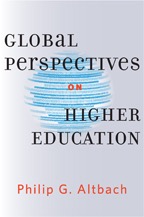Global Perspectives on Higher Education

- Author
- Altbach,, Philip G.
- Publisher
- Johns Hopkins University Press
- Date Reviewed
- June 24, 2024
- Reviewer
- Joanne Maguire, University of North Carolina - Charlotte
This sprawling volume, which incorporates co-written essays alongside those written by the main author, focuses on several themes in global higher education in the last half century, including massification, systemic inequalities, and the hegemonic role of English. Key areas where higher education has changed significantly include Asia, India, and Latin America; Africa still lags behind in many ways. The book is organized in five major sections: “The Global Context”; “The Implications of Globalization”; “Centers and Peripheries”; “Comparative Perspectives”; and “Teachers and Students.” This review will focus mostly on the final section as most relevant to the readership of this online publication.
The authors aim high in their goal of surveying the landscape of rapidly globalizing higher education over fifty or so years. The first few chapters provide a modicum of historical perspective on higher education and go on to examine the most recent “revolution” in higher education through four interrelated forces: “mass higher education, globalization, the advent of the knowledge society and the importance of research universities in it, and information technology” (16). The author(s) note that these forces have fed the growth of privatization, international rankings, and burdensome systems of assessment, among other developments. The essays in the following sections focus in different and sometimes overlapping ways on those themes, noting that the recent internationalization of universities is a necessary response to increased globalization. Anyone who works in higher education would come away with a better general understanding, if not an in-depth knowledge, of trends in higher education after reading these chapters. Depending on the topic, Altbach and his occasional co-authors provide few citations for their claims; for instance, the chapter on “The Globalization of Rankings” includes just one reference, to an essay by Malcolm Gladwell in The New Yorker. Consequently, this volume will be of limited use for those wishing to pursue their own research in these areas.
The final section (Chapters Seventeen and Eighteen) is titled “Teachers and Students,” but it is more accurately about the ways academic work is contracted for and compensated as well as reasons for student political activism. Both topics yield slippery data, so both chapters seem more tentative than definitive. It is clear from the data that they do use that disparities in remuneration and opportunity are widespread across academia worldwide. It is also clear that nobody truly understands the driving forces behind student activism except in certain local cases. Neither chapter addresses issues related to curriculum or pedagogy as they focus more on broader institutional and bureaucratic issues. This is perhaps necessary given the broad sweep of this book overall, but it also means that this book will be of less use to readers of this journal than one more focused on actual classrooms and pedagogical continuities and changes around the world. Despite this, readers looking for an overview of the ways globalization has driven the internationalization of higher education will appreciate the broad sweep of this volume.